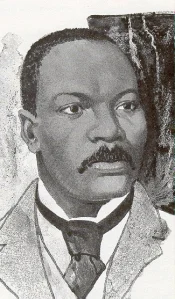Granville T. Woods was an African American born in Columbus, Ohio on this date in 1856. The most prolific African-American inventor of the late 19th and early 20th centuries, he came up with numerous inventions including a steam-boiler furnace, telephone, telegraph system, electric railway and automatic air brake for railroad safety. If you thought that whites, and in particular Thomas Edison, would get the most credit for these ideas, you would be correct. Black inventors had little if any protection for their intellectual property at this time in history.
Woods only attended school until the age of ten. Thereafter, while working in a machine shop repairing railroad equipment and machinery, he became intrigued by the electricity that powered the machinery. He studied machine workers as they worked with equipment and paid other workers to sit down and explain electrical concepts to him. Eventually, he was able to afford formal engineering training.
Unfortunately, despite his high aptitude and valuable education and expertise, Woods was denied opportunities and promotions because of the color of his skin. Out of frustration and a desire to promote his abilities, Woods, along with his brother Lyates, formed the Woods Railway Telegraph Company in 1884.
The company manufactured and sold telephone, telegraph and electrical equipment. Inventions developed by the company included an improved steam boiler furnace and an improved telephone transmitter. In 1885, Woods patented a system combining the telephone and telegraph thus allowing stations to send voice and telegraph messages over a single wire. The device was so successful that he later sold it to the American Bell Telephone Company. (As a Black inventor, Woods had difficulty in marketing his inventions and had little choice but to sell them to white-owned corporations.)
In 1887, Woods developed a telegraph that allowed for messages to be sent from moving trains and railway stations. By enabling dispatchers to know the location of each train, it provided for greater safety and a decrease in railway accidents.
Granville Woods often had difficulties in enjoying his success as other inventors made claims to his devices. Thomas Edison made one of these claims, stating that he had first created a similar telegraph and that he was entitled to the patent for the device. Woods was twice successful in defending himself, proving that there were no other devices upon which he could have depended or relied upon to make his own.
Over the course of his lifetime Granville Woods would obtain more than 50 patents for inventions, including an automatic brake and an egg incubator and patents for improvements to other inventions such as safety circuits, telegraphs, telephones, and phonographs. When he died on January 30, 1910 in New York City he had become an admired and well-respected inventor. Nevertheless, he spent the last years of his life in virtual poverty as he battled in court for control of his inventions.
You can learn more about Woods in the book Black Inventors in the Age of Segregation by Rayvon Fouchi.
The author examines the life and work of three African Americans: Granville Woods (1856–1910), an independent inventor; Lewis Latimer (1848–1928), a corporate engineer with General Electric; and Shelby Davidson (1868–1930), who worked in the U.S. Treasury Department. Fouchi explains how each man used invention as a means to technical stature in a Jim Crow institutional setting. As Johns Hopkins University Press writes, “Fouchi provides a nuanced view of African American contributions to — and relationships with — technology during a period of rapid industrialization and mounting national attention to the inequities of a separate-but-equal social order.”
Filed under: History | Tagged: Black History, History |







Leave a comment